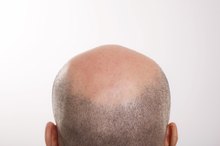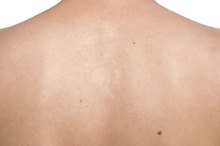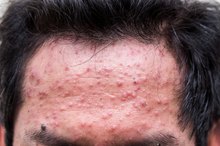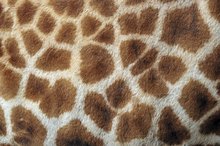Facial Fungus: The Symptoms
Molds, yeasts and fungi all belong to the fungi kingdom. Some of these, including candida albicans and malassezia, commonly reside on the skin without causing harm. When skin is injured or cut, fungi have the opportunity to enter skin and cause infection. When one does infect, symptoms can range from a mild itch to serious illness.
Tinea Faciale
Ringworm is caused by a type of fungi called dermatophytes. Dermatophytes are common, microscopic fungi that can live in a number of environments, including soil, human skin, objects, and animals, including dogs and cats. Dermatophytes can infect any part of the body where there is keratin, a protein found in the dead skin cells that form the outer layer of skin, in hair shafts and in nails. Ringworm forms an expanding, red, slightly raised rash with a central, clear area. The edge of the rash is often distinct and may be scaly or contain blisters. Over the course of the outbreak, the ring expands and multiple areas of infection are common. When ringworm occurs on the face, it is called tinea faciale. Skinsight.com explains that the most common areas for tinea faciale to occur are the cheeks, nose, chin, around the eye and on the forehead.
- Ringworm is caused by a type of fungi called dermatophytes.
- Dermatophytes are common, microscopic fungi that can live in a number of environments, including soil, human skin, objects, and animals, including dogs and cats.
Tinea Barbae
Scalp Conditions That Cause Hair Loss
Learn More
In men and in women who have thick, course hair on the face, ringworm can infect the beard and mustache area. When it does, the fungi damage hair near to the skin, and patches of hair break off. DermaNet NZ reports that tinea barbae is rarely transferred from person to person, but that farmers often contract the infection from infected animals. Red, lumpy areas, inflammation and pustules characterize the patches of infected skin.
- In men and in women who have thick, course hair on the face, ringworm can infect the beard and mustache area.
Tinea Versicolor
Tinea versicolor, also called pityriasis versicolor, is caused by a yeast-like fungus called malassezia 3. Malassezia is commonly found on healthy skin, where it lives in pores. According to the American Academy of Dermatology, it normally resides in oily areas of the skin. The chest and back are common areas for the infection, though it can also be found on the face, neck and other areas. The infection is more common in young adults and teenagers and is rare in the elderly or in children, except in tropical climates, where it affects people of all ages. The infection causes discolored spots to appear on the skin, as it affects pigment production. The discolorations are often white-to-pink or tan-to-dark.
- Tinea versicolor, also called pityriasis versicolor, is caused by a yeast-like fungus called malassezia 3.
- The infection causes discolored spots to appear on the skin, as it affects pigment production.
Candidiasis
Complications of Ringworm
Learn More
Caused by yeasts of the genus candida, candidiasis can cause a brownish-red area of discoloration at the corners of the mouth. Candida is normally found in the gastrointestinal tract. When it infects the skin or mucous membranes, it is called superficial candidiasis. Candidiasis also commonly appears under the arms and breasts and in the rectal area. It can cause a vaginal yeast infection in women. The rash may be itchy.
- Caused by yeasts of the genus candida, candidiasis can cause a brownish-red area of discoloration at the corners of the mouth.
Related Articles
References
- Quick Care: Fungus Infections
- Fungal Guide: What Are the Types of Skin Fungus?
- Skin Sight: Tinea Versicolor
- Gupta AK, Foley KA. Antifungal treatment for pityriasis versicolor. J Fungi (Basel). 2015;1(1):13-29. doi:10.3390/jof1010013
- El-gohary M, Van zuuren EJ, Fedorowicz Z, et al. Topical antifungal treatments for tinea cruris and tinea corporis. Cochrane Database Syst Rev. 2014;(8):CD009992. doi:10.1002/14651858.CD009992.pub2
- Toukabri N, Dhieb C, El euch D, Rouissi M, Mokni M, Sadfi-zouaoui N. Prevalence, etiology, and risk factors of tinea pedis and tinea unguium in Tunisia. Can J Infect Dis Med Microbiol. 2017;2017:6835725. doi:10.1155/2017/6835725
- Sahoo AK, Mahajan R. Management of tinea corporis, tinea cruris, and tinea pedis: A comprehensive review. Indian Dermatol Online J. 2016;7(2):77-86. doi:10.4103/2229-5178.178099
- Hay RJ. Tinea capitis: Current status. Mycopathologia. 2017;182(1-2):87-93. doi:10.1007/s11046-016-0058-8
- Furlan KC, Kakizaki P, Chartuni JC, Valente NY. Sycosiform tinea barbae caused by trichophyton rubrum and its association with autoinoculation. An Bras Dermatol. 2017;92(1):160-161. doi:10.1590/abd1806-4841.20174802
- Christenson JK, Peterson GM, Naunton M, et al. Challenges and Opportunities in the Management of Onychomycosis. J Fungi (Basel). 2018;4(3). doi:10.3390/jof4030087
- Metin A, Dilek N, Bilgili SG. Recurrent candidal intertrigo: challenges and solutions. Clin Cosmet Investig Dermatol. 2018;11:175-185. doi:10.2147/CCID.S127841
- InformedHealth.org. Oral thrush (oral candidiasis): Overview. Cologne, Germany: Institute for Quality and Efficiency in Health Care (IQWiG). Updated May 18, 2016.
- Ferree SD, Yang C, Kourosh AS. Autosensitization dermatitis: A case of rosacea-like id reaction. JAAD Case Rep. 2019;5(5):410-412. doi:10.1016/j.jdcr.2019.02.029
Writer Bio
Katherine Mariaca is a professional freelance journalist who specializes in alternative and complementary medicine, and skin and body care treatments. A longtime spa director and VP of skin care companies, Mariaca developed products and services for the spa industry. She earned a B.S. from Tufts and an M.F.A. from Lesley.









